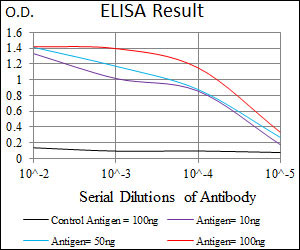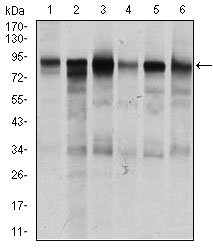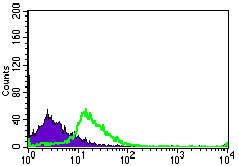TGFBR3 Antibody
Purified Mouse Monoclonal Antibody
- 产品详情
- 实验流程
Application
| WB, FC, E |
|---|---|
| Primary Accession | Q03167 |
| Reactivity | Human, Mouse |
| Host | Mouse |
| Clonality | Monoclonal |
| Clone Names | 1C5H11 |
| Isotype | IgG2b |
| Calculated MW | 93499 Da |
| Description | This locus encodes the transforming growth factor (TGF)-beta type III receptor. The encoded receptor is a membrane proteoglycan that often functions as a co-receptor with other TGF-beta receptor superfamily members. Ectodomain shedding produces soluble TGFBR3, which may inhibit TGFB signaling. Decreased expression of this receptor has been observed in various cancers. Alternatively spliced transcript variants encoding different isoforms have been identified for this gene. |
| Immunogen | Purified recombinant fragment of human TGFBR3 (AA: 147-328 ) expressed in E. Coli. |
| Formulation | Ascitic fluid containing 0.03% sodium azide. |
| Gene ID | 7049 |
|---|---|
| Other Names | Transforming growth factor beta receptor type 3, TGF-beta receptor type 3, TGFR-3, Betaglycan, Transforming growth factor beta receptor III, TGF-beta receptor type III, TGFBR3 |
| Dilution | WB~~1/500 - 1/2000 FC~~1/200 - 1/400 E~~1/10000 |
| Storage | Maintain refrigerated at 2-8°C for up to 6 months. For long term storage store at -20°C in small aliquots to prevent freeze-thaw cycles. |
| Precautions | TGFBR3 Antibody is for research use only and not for use in diagnostic or therapeutic procedures. |
| Name | TGFBR3 (HGNC:11774) |
|---|---|
| Function | Cell surface receptor that regulates diverse cellular processes including cell proliferation, differentiation, migration, and apoptosis (PubMed:12958365, PubMed:19416857). Initiates BMP, inhibin, and TGF-beta signaling pathways by interacting with different ligands including TGFB1, BMP2, BMP5, BMP7 or GDF5 (PubMed:18184661). Alternatively, acts as a cell surface coreceptor for BMP ligands, serving to enhance ligand binding by differentially regulating BMPR1A/ALK3 and BMPR1B/ALK6 receptor trafficking (PubMed:19726563). Promotes epithelial cell adhesion, focal adhesion formation and integrin signaling during epithelial cell spreading on fibronectin (PubMed:22562249). By interacting with the scaffolding protein beta- arrestin2/ARRB2, regulates migration or actin cytoskeleton and promotes the activation of CDC42 as well as the inhibition of NF-kappa-B (PubMed:19416857, PubMed:19325136). In gonadotrope cells, acts as an inhibin A coreceptor and regulates follicle-stimulating hormone (FSH) levels and female fertility (By similarity). Plays a role in the inhibition of directed and random cell migration in epithelial cells by altering the actin cytoskeletal organization (PubMed:19416857). Participates in epithelial-mesenchymal transformation (EMT) upon binding to BMP2 or TGFB2, by activating the PAR6/SMURF1/RHOA pathway (By similarity). |
| Cellular Location | Cell membrane; Single-pass type I membrane protein. Secreted {ECO:0000250|UniProtKB:P26342}. Secreted, extracellular space, extracellular matrix {ECO:0000250|UniProtKB:P26342}. Note=Exists both as a membrane-bound form and as soluble form in serum and in the extracellular matrix. {ECO:0000250|UniProtKB:P26342} |
Research Areas
For Research Use Only. Not For Use In Diagnostic Procedures.
Application Protocols
Provided below are standard protocols that you may find useful for product applications.
REFERENCES
1.Mol Biol Cell. 2011 May;22(9):1463-72. 2.Zhongguo Fei Ai Za Zhi. 2010 May;13(5):451-7.
终于等到您。ABCEPTA(百远生物)抗体产品。
点击下方“我要评价 ”按钮提交您的反馈信息,您的反馈和评价是我们最宝贵的财富之一,
我们将在1-3个工作日内处理您的反馈信息。
如有疑问,联系:0512-88856768 tech-china@abcepta.com.























 癌症的基本特征包括细胞增殖、血管生成、迁移、凋亡逃避机制和细胞永生等。找到癌症发生过程中这些通路的关键标记物和对应的抗体用于检测至关重要。
癌症的基本特征包括细胞增殖、血管生成、迁移、凋亡逃避机制和细胞永生等。找到癌症发生过程中这些通路的关键标记物和对应的抗体用于检测至关重要。 为您推荐一个泛素化位点预测神器——泛素化分析工具,可以为您的蛋白的泛素化位点作出预测和评分。
为您推荐一个泛素化位点预测神器——泛素化分析工具,可以为您的蛋白的泛素化位点作出预测和评分。 细胞自噬受体图形绘图工具为你的蛋白的细胞受体结合位点作出预测和评分,识别结合到自噬通路中的蛋白是非常重要的,便于让我们理解自噬在正常生理、病理过程中的作用,如发育、细胞分化、神经退化性疾病、压力条件下、感染和癌症。
细胞自噬受体图形绘图工具为你的蛋白的细胞受体结合位点作出预测和评分,识别结合到自噬通路中的蛋白是非常重要的,便于让我们理解自噬在正常生理、病理过程中的作用,如发育、细胞分化、神经退化性疾病、压力条件下、感染和癌症。









